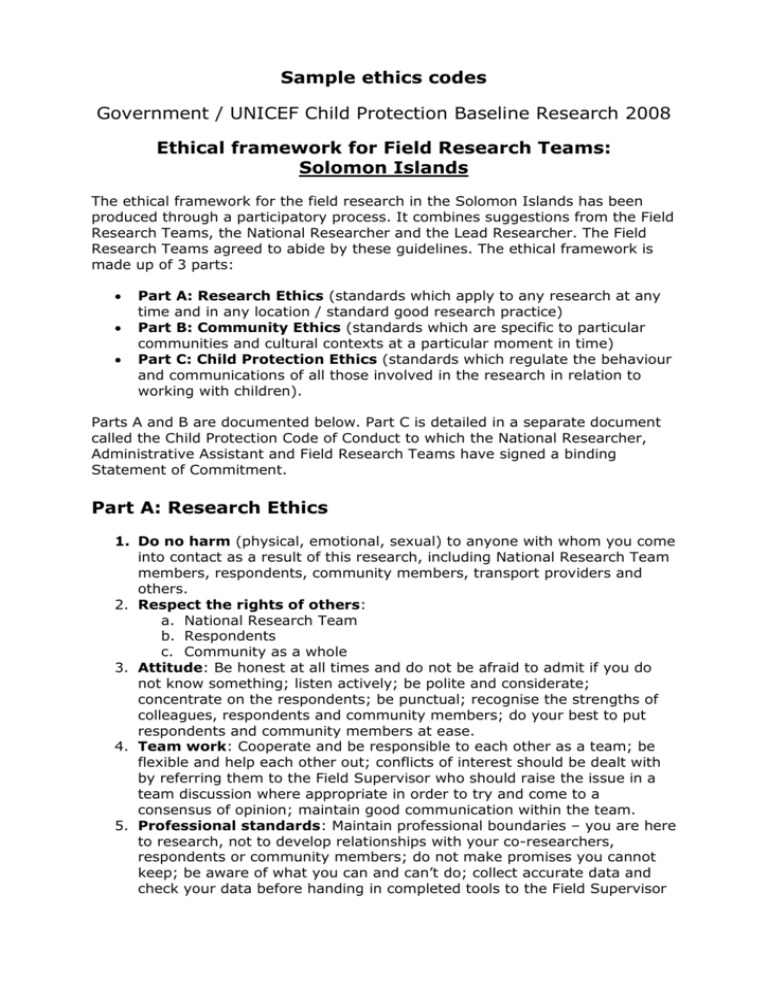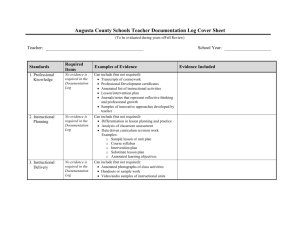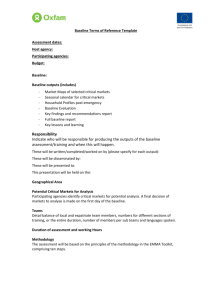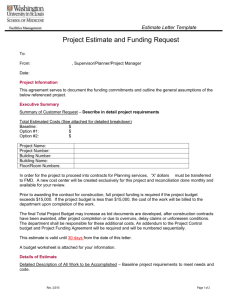Sample ethics codes
advertisement

Sample ethics codes Government / UNICEF Child Protection Baseline Research 2008 Ethical framework for Field Research Teams: Solomon Islands The ethical framework for the field research in the Solomon Islands has been produced through a participatory process. It combines suggestions from the Field Research Teams, the National Researcher and the Lead Researcher. The Field Research Teams agreed to abide by these guidelines. The ethical framework is made up of 3 parts: Part A: Research Ethics (standards which apply to any research at any time and in any location / standard good research practice) Part B: Community Ethics (standards which are specific to particular communities and cultural contexts at a particular moment in time) Part C: Child Protection Ethics (standards which regulate the behaviour and communications of all those involved in the research in relation to working with children). Parts A and B are documented below. Part C is detailed in a separate document called the Child Protection Code of Conduct to which the National Researcher, Administrative Assistant and Field Research Teams have signed a binding Statement of Commitment. Part A: Research Ethics 1. Do no harm (physical, emotional, sexual) to anyone with whom you come into contact as a result of this research, including National Research Team members, respondents, community members, transport providers and others. 2. Respect the rights of others: a. National Research Team b. Respondents c. Community as a whole 3. Attitude: Be honest at all times and do not be afraid to admit if you do not know something; listen actively; be polite and considerate; concentrate on the respondents; be punctual; recognise the strengths of colleagues, respondents and community members; do your best to put respondents and community members at ease. 4. Team work: Cooperate and be responsible to each other as a team; be flexible and help each other out; conflicts of interest should be dealt with by referring them to the Field Supervisor who should raise the issue in a team discussion where appropriate in order to try and come to a consensus of opinion; maintain good communication within the team. 5. Professional standards: Maintain professional boundaries – you are here to research, not to develop relationships with your co-researchers, respondents or community members; do not make promises you cannot keep; be aware of what you can and can’t do; collect accurate data and check your data before handing in completed tools to the Field Supervisor – you are responsible for the information you collect and will be held accountable for errors. 6. Informed consent: Researchers must read out the informed consent instructions for each of the research tools (adult and child household questionnaires, group activities and key informant interviews) and sign the relevant informed consent sheets. 7. Confidentiality: [see Code of Conduct for details] 8. Impartiality: Do not show favouritism with colleagues, respondents and community members; do not discriminate against anyone with whom you come into contact as a result of the research on the basis of sex, religion, language, ethnicity, sexuality or any other grounds 9. Transparency: Decision-making and disciplinary processes must be transparent (i.e. everyone should know how things are done); the same process must be applied to everyone, regardless of who they are; however, whilst processes are transparent, the information that passes through these processes may be confidential. 10.Health and safety: The Field Supervisor, and ultimately the National Researcher, are responsible for the health and safety of the Field Research Teams; Field Research Teams shall not be put at unnecessary risk; the National Researcher and Field Supervisors are expected to assess risks and to put in place steps to manage risk; there is one first aid kit provided per team; there is one lifejacket provided per researcher where boat travel is involved; researchers should work in pairs; researchers should always know where other team members are in case of emergency; do not move away from the team without telling others where you are going and what time you will be back. 11.Share findings: Final reports from the research will be shared with the key contact from each research location by the end of 2008. Part B: Community Ethics 1. Dress code: a. No camouflage / military print clothes or military style clothes to be worn by researchers b. Men – shorts or trousers below the knee c. Women – dress or skirt below the knee (no shorts or trousers) 2. Hygiene: Maintain a good standards of personal hygiene. 3. Homebrew / alcohol / kava: Drinking is not allowed during the period of the research unless expressly allowed by the Field Supervisor in special circumstances where it would be rude to not drink something which the community has offered. However, even in these exceptional circumstances, moderation must be employed. Breaches of this guideline will be taken very seriously. 4. Smoking: a. No smoking or displaying of cigarette packets in front of children (even whilst ‘off-duty’); b. No smoking during data collection (household questionnaires, interviews, group activities, or discussions with community leaders); c. Dispose of cigarette ends, packets and packaging properly – no littering. 5. Drugs: No non-prescription drugs to be taken during the course of the research. 6. Betel nut: No chewing during data collection (household questionnaires, interviews, group activities, or discussions with community leaders). 7. Language: No swearing; use simple, polite language; no derogatory (bad or negative) words to be used about people of another religion, ethnic group, province, sex, age etc.; avoid words which have different meanings in different languages. This applies to the whole period of the research both ‘on’ and ‘off-duty’. 8. Body language: No inappropriate or rude gestures; show respect and attentiveness in your body language. This applies to the whole period of the research both ‘on’ and ‘off-duty’. 9. Physical environment: Respect ‘tabu’ sites; consider the venue of the data collection to make sure it is safe, culturally appropriate and as private as possible; care for the community environment and property – no littering or vandalism. 10.Cultural context: Show respect for cultural practices, religious and community activities - although if you witness something which is causing harm to a child then report this to the Field Counselor; the National Research, Administrative Assistant and Field Supervisors must observe culturally appropriate protocols during preparation, entry into the community, during the research and exiting from the community. Child Protection Code of Conduct1 The Code of Conduct should be interpreted in a spirit of transparency and common sense, with the best interests of the child as the primary consideration. Baseline Research associates must make an attempt to understand the local norms around physical contact between children and adults. These guidelines apply to the interaction of any Baseline Research Associate with anyone under the age of 18. Where possible, this Code of Conduct should be shared with, and explained to, community leaders upon arrival in a community. Permission should be sought from the relevant community leaders with regards to taking photographs for either official research or personal reasons. Part A: Behaviour guidelines Minimising risk situations: o Try to: avoid placing yourself in a compromising or vulnerable position; be accompanied by a second adult whenever possible; meet with a child in a central, public location whenever possible; immediately note, in a designated organisational Child Protection Log Book or incident report sheet, the circumstances of any situation which occurs which may be subject to These behaviour guidelines are based on the child protection policies of World Vision, Save the Children UK, Tearfund , Sense International and Learning for Life, adapted by UNICEF Pacific staff members and the Fiji Child Protection Baseline Research Field Research Team. 1 o misinterpretation; keep in mind that actions, no matter how well intended, are always subject to misinterpretation by a third party. Try not to be alone with a single child, including in the following situations: in a car (no matter how short the journey); overnight (no matter where the accommodation); in your home or the home of a child. Do not show favouritism or spend excessive amounts of time with one child. Sexual behaviour: o Do not: engage in or allow sexually provocative games with children to take place; kiss, hug, fondle, rub, or touch a child in an inappropriate or culturally insensitive way; use language that sexualises a child; encourage any crushes by a child; create, view or distribute images in any format (print or electronic) of a child who is not appropriately clothed and / or who is depicted in any poses that could be interpreted as sexually inappropriate. In relation to children with whom you have a professional relationship, do not sleep in the same bed or do things of a personal nature that a child could do for him/herself, including dressing, bathing, and grooming. Physical behaviour: o Do: wait for appropriate physical contact, such as holding hands, to be initiated by the child, except in situations where it is expected for adults to greet children by offering them their hand. o Do not: Hit or threaten to hit a child either with a hand or other implement; otherwise physically hurt or physically abuse a child or threaten to do so. Psychosocial behaviour: o Do: Be aware of the power balance between an adult and child, and avoid taking any advantage this may provide; be aware that as a member of the research team, your presence with children will often be temporary and you should therefore avoid creating bonds with children which encourage emotional or psychological dependency: make it clear to children from the outset, in age-appropriate terms, that you will not be with them long-term; listen to and respect children’s views; encourage children’s positive behaviour. o Do not: use language that will mentally or emotionally harm any child; suggest inappropriate behaviour or relations or any kind; act in any way that intends to embarrass, shame, humiliate, or degrade a child; encourage any inappropriate attention-seeking behaviour, such as tantrums, by a child; show discrimination of race, culture, age, gender, disability, religion, sexuality, or political persuasion; pressure a child to participate in any activity. Peer abuse: o Do: be aware of the potential for peer abuse; be aware of the power balances between children (based on age, sex, ethnicity etc.) and avoid creating situations where children can exploit these differences to abuse each other; develop special measures / supervision to protect younger and especially vulnerable children; avoid placing children in high-risk peer situations (e.g. unsupervised mixing of older and younger children); encourage children to develop mutually agreed peer codes of conduct or ‘ground rules’ including not hitting, bullying or intimidating each other. o Do not: allow children to engage in sexually provocative games with each other. Physical environment: o Do: develop clear rules to address specific physical safety issues relative to the local physical environment of a project (e.g. for projects based near water or heavy road traffic); provide for gender-sensitive facilities such as separate toilets and showers for girls and boys. Behaviour with other family members and colleagues o o Do: Treat all family members and colleagues, regardless of age or sex, with respect and courtesy. Do not: Harm or threaten to harm any family member or colleague, regardless of age or sex, either physically, sexually or emotionally. This includes – do not: hit (either with a hand or other implement), intimidate, bully or sexually coerce or harass any family member or colleague. Confidentiality o Do: Inform respondents that their identity will remain anonymous, as stated in the research tools; share concerns – but only with the Field Counselor o Do not: Reveal any personal information about respondents to anyone except the Field Counselor; pry for information from a respondent if they have not volunteered such information themselves. Part B: Photograph guidelines All photographs taken as part of the Child Protection Baseline research, whether official or personal, shall comply with the ‘communication guidelines’ set out in Part C of this Code of Conduct. No photographs, whether official or personal, shall be disseminated via the internet without express permission of the Lead Researcher. This includes via social networking pages such as ‘Facebook’. B.1. Photographs for the Baseline Research: Where possible, a Field Research Team member with a digital camera will be given specific responsibility by the Field Supervisor to document the following in each location: o Drawings, flipcharts and other outputs produced by the group activities; o General pictures which give an overview of the community – types of photographs to be decided in conjunction with the Field Supervisor. The photographs shall be digitally stored under clearly identifiable file names and digital copies shall be provided to the National Researcher at the end of the field research. B.2. Personal photographs: The Field Research Team is permitted to take personal photographs during the field research under the following conditions: o That such photographs comply with the communication guidelines in Part C of this Code of Conduct with regard to informed consent, appropriateness of clothing and dignity of the child and community, amongst other things. o That the taking of such photographs does not interfere with the conduct of the field research: no photographs are to be taken whilst the Field Research Team is in the process of using any of the research tools (household questionnaires, group activities or key informant interviews). The exception to this is official research photographs taken by the designated team member (see above). If a Field Research Team member is in doubt about the appropriateness of a particular photograph, they should submit the photograph to the Team, including the Team Leader, for discussion. PART C: Communication guidelines2 Access to printed and electronic personal information about children should be restricted to the minimum number of people who need to know within the Baseline Research Team. Personal and physical information that could be used to identify the location of a child within a country and cause them to be put at risk should not be used on any website or in any other form of communication for general or public purposes. Every child has a right to be accurately represented through both words and images. The Baseline Research’s portrayal of each child must not be manipulated or sensationalized in any way. Children must be presented as human beings with their own identity and dignity preserved. Text and images included in any print, broadcast or electronic materials such as brochures, publications, reports, videos or websites should depict an accurate and balanced depiction of children and their circumstances. Sufficient information should be provided where possible as to their social, cultural and economic environment. Where children are indeed ‘victims’, the preservation of the child’s dignity must nevertheless be preserved at all times. In these circumstances, ‘before’ and ‘after’ pictures are useful to depict a balance between victimisation and empowerment. As far as possible, people [including children] should be able to give their own accounts rather than have people speak on their behalf, and people’s [including children’s] ability to take responsibility and action for themselves should be highlighted.3 Avoid: Language and images that could possibly degrade, victimise or shame children; Making generalisations which no not accurately reflect the nature of the situation; Discrimination of any kind; Taking pictures out of context (e.g. pictures should be accompanied by an explanatory caption where possible). In images, children should be appropriately clothed and not depicted in any poses that could be interpreted as sexually inappropriate. Always ask permission from the child / children themselves before taking photographs or moving images except under exceptional circumstances, based on the child / children’s best interests, where this might not be possible or desirable. To the greatest extent possible, the Baseline Research should acquire informed consent / the permission of the child, child’s guardian and/or NGO responsible for the child in order to use the image for publicity, fundraising, awareness-raising or other purpose (which should be made clear to the consent-giver). Individuals or organisations requesting the use of the Baseline Research’s resources such as photographs should be required to sign an agreement with the Baseline The majority of these guidelines are based on the following sources: Code of Conduct: Images and messages relating to the Third World, Liaison Committee of Development NGOs to the European Union, April 1989, Practical Guidelines; World Vision Guidelines on the Use of Images and Messages Relating to the Developing World; World Vision Child Protection Policy. 3 World Vision Guidelines on the Use of Images and Messages Relating to the Developing World, No. 3. 2 Research Team as to the proper use of such materials. The agreement could include a statement that any use of such materials for purposes other than what is agreed upon could subject the borrowing individual or organisation to legal action. Furthermore, failure to adhere to the agreed use of the material will result in the immediate termination of the organisation’s permission to use the subject materials and/or require immediate return of all materials (including any copies made) provided by the Baseline research.4 4 Adapted from World Vision Child Protection Policy, section 8.4. Government / UNICEF Child Protection Baseline Research Child Protection Code of Conduct Statement of Commitment: SOLOMON ISLANDS I hereby declare that I have read and understood the Child Protection Code of Conduct and that I will comply with the guidelines therein for the duration of the Child Protection Baseline Research. I understand that failure to comply with the Child Protection Code of Conduct may result in disciplinary action, including termination of my contract. Job title (tick as appropriate): National Researcher Administrative / Research Assistant Field Supervisor Field Counselor Field Researcher Print full name:_____________ Signature:_________________ Date: ____________________ Government / UNICEF Child Protection Baseline Research 2008 Confidentiality agreement This agreement applies to all personnel involved in data analysis who have not signed the full Code of Conduct. Anyone likely to have direct contact with children in the course of their duties associated with the Baseline Research must sign the full Code of Conduct. 1. I hereby agree that all data to which I have access in relation to the Child Protection Baseline Research, regardless of medium (print or electronic, text, oral or visual) will remain confidential in order to protect the anonymity and therefore safety of respondents, researchers and others who have taken part in the research. 2. I will not disclose any findings from the research to anyone outside the immediate research team consisting of [insert names]. 3. Enquiries from anyone outside this immediate team regarding the research findings or any other information which may be considered confidential 5 will be directed to [insert name] who will confer with [insert name] if in doubt as to how to handle the enquiry. This includes enquiries coming from Government or NGO partners, the Steering Committee and UNICEF staff and associates not listed above by name. 4. I will not make copies (paper, electronic, audio or visual) of any documents or information associated with the Baseline Research without the express permission of a member of the immediate research team listed above. 5. I will ensure that any information from the Baseline Research (regardless of medium) which is entrusted to my care, even on a temporary basis, will be stored securely at all times (i.e. accessible only to the immediate research team). 6. I will maintain the level of confidentiality outlined in this agreement throughout and beyond the completion of the Baseline Research project. 7. Following the public release / distribution / publication of the [insert name]National Report I am free to discuss any and all findings contained within the report. However, this will be without reference to any further information to which I have had access during the course of the research which is not contained in the public report, unless written permission is given by [insert names]. Name: _____________________ Signature: _____________________ Date: _____________________ Place: _____________________ E.g. identity of respondents, field researchers or their contact details; photographs of the field research; anything which might put the safety or privacy of people associated with the research at risk; anything which might compromise the integrity of the research. If in doubt, seek advice from [insert names]. 5







